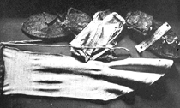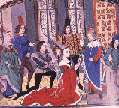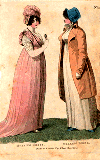

Clothing can tell us a great deal about social values in a given period. The evolution of dress can be seen as a visual history of a culture. Also, since there are very few new ideas in the world, costume history serves as a source of creative ideas that designers and retailers of fashion can recombine to create the new fresh looks that will be brought forth each season.

How do we know what people wore in the past? We can look at actual garments, though few examples exist that are older than the 18th century.



We will look at some of the major style changes in Euro-American dress in the last 200 years. During most of this period, women's dress has been subject to greater change than has men's, (though men's dress was much more varied and fashion-sensitive earlier). We will discuss men's dress separately.
Prior to 1795 women's fashions had retained more or less the same silhouette, with minor variations, for about 300 years, defined by corsetting. Earlier, during the medieval period, dress had been semifitted, and favored a body silhouette in which the a round belly and full hips dominated, with neither the waist nor breasts a focus of attention until later. Beginning at the end of the 15th century, the fitted and corsetted bodice accentuated both waist and breasts, with massive long skirts in various forms completing the silhouette.
We will focus on the evolution of dress after 1795. The periods we will look at are:

This period, referred to as Regency style in England, followed the French and American revolutions. It saw a drastic shift in dress for both men and women, though for women this change would be short lived. Classical Greek and Roman images were evoked to justify the democratic revolutions of this period. This resulted in the adoption of a classically inspired silhouette for women which was long, narrow, uncorsetted, and high-waisted. Initially the color of choice was white, and the fabrics soft cottons, often virtually transparent. Shawls and long gloves were introduced to cover bare shoulders and arms; shawls would remain in fashion until the advent of the bustle in the 1880's. Hair might be cut short, and turbans and caps were worn.
After 1805, as society began to return to a more sedate, conservative mode, and as the
aristocracy returned to France, dress gradually became less semi-fitted and more tailored.
Bodices became more fitted, more surface decoration was used, as well as heavier fabrics and
more modest long sleeves. As it turned out, the revolutions had opened up new opportunities
for men; but for women, life would continue much as it had before. Therefore the dress forms
would also return to those that had been in use for centuries.
For a selection of fashion drawings from this period, see this Regency Fashion site.
 |